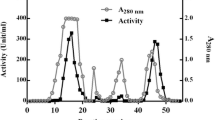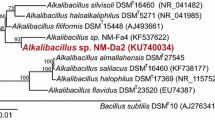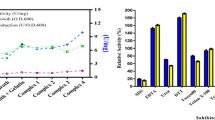Abstract
In this work, we report on the halophilic bacterium Halobacillus blutaparonensis strain M9, which was isolated from a preserved Brazilian restinga, as a producer of alkaline serine peptidases with potential application as additives for biotechnological purposes. Gelatin-zymography assay revealed the presence of the major peptidase of 70 kDa and two minor ones (50 and 40 kDa) secreted by the living bacterial cells. When a specific chromogenic substrate for chymotrypsin-type serine peptidases was employed by means of an in-solution assay, the bacterial peptidases were completely inhibited by phenylmethylsulphonyl fluoride (PMSF) and slightly inhibited by benzamidine, N-tosyl-L-lysine chloromethyl ketone (TLCK) and 4-(2-aminoethyl) benzenesulfonyl fluoride hydrochloride (AEBSF), which are classical serine peptidase inhibitors. The proteolytic activity remained extremely stable within a broad pH range (from 5.0 to 9.0) and also displayed moderate thermostability. In addition, the effects of osmolytes/polyols, divalent cations, denaturing agents, and detergents on the enzymatic activity and stability of these serine peptidases were tested. The proteolytic activity increased in the presence of different osmolytes/polyols (e.g., glycerol, glutamate, and mannitol). The enzymatic activity increased to 110% when incubated in the presence of 10 mM Ca2+, while Mg2+ and Mn2+ (both at 10 mM) decreased the proteolytic activity to 95 and 85%, respectively. Interestingly, urea at 1% induced a significant increase (around 160%) in the proteolytic activity. The peptidases showed high stability when incubated with various detergent agents and commercial detergent powders. Collectively, all these properties indicate H. blutaparonensis as a producer of extracellular serine peptidases with possible industrial applications, such as in detergent formulations.







Similar content being viewed by others
REFERENCES
Alvarez, V.M., Von der Weid, I., Seldin, L., and Santos, A.L.S., Influence of growth conditions on the production of extracellular proteolytic enzymes in Paenibacillus peoriae NRRL BD-62 and Paenibacillus polymyxa SCE2, Lett. Appl. Microbiol., 2006, vol. 43, pp. 625–630.
Anwar, A. and Saleemuddin, M., Alkaline protease from Spilosoma obliqua: potential applications in bio-formulations, Biotechnol. Appl. Biochem., 2000, vol. 31, pp. 85–89.
Badgujar, S.B. and Mahajan, R.T., Identification and characterization of Euphorbia nivulia latex proteins, Int. J. Biol. Macromol., 2014, vol. 64, pp. 193–201.
Benjamin, S., Smitha, R.B., Jisha, V.N., Pradeep, S., Sajith, S., Sreedevi, S., Priji, P., Unni, K., and Josh, M., A monograph on amylases from Bacillus spp, Adv. Biosci. Biotechnol., 2013, vol. 4, pp. 227–241.
Betzel, C., Klupsch, S., Branner, S., and Wilson, K.S., Crystal structures of the alkaline proteases savinase and esperase from Bacillus lentus, Adv. Exp. Med. Biol., 1996, vol. 379, pp. 49–61.
Borgi, I. and Gargouri, A., Investigations on a hyper-proteolytic mutant of Beauveria bassiana: broad substrate specificity and high biotechnological potential of a serine protease, FEMS Microbiol. Lett., 2014, vol. 351, pp. 23–31.
Bressollier, P., Letourneau, F., Urdaci, M., and Verneuil, B., Purification and characterization of a keratinolytic serine proteinase from Streptomyces albidoflavus, Appl. Environ. Microbiol., 1999, vol. 65, pp. 2570–2576.
Chamroensaksri, N., Akaracharanya, A., Visessanguan, W., and Tanasupawat, S., Characterization of halophilic bacterium Nb2-1 from Pla-Ra and its protease production, J. Food. Biochem., 2008, vol. 32, pp. 536–555.
Da Costa, M.S., Santos, H., and Galinski, E.A., An overview of the role and diversity of compatible solutes in Bacteria and Archaea, Adv. Biochem. Eng. Biotechnol., 1998, vol. 61, pp. 117–153.
Danson, M.J. and Hough, D.W., The structural basis of protein halphilicity, Comp. Biochem. Physiol., 1997, vol. 117, pp. 307–312.
DelMar, E.G., Largman, C., Brodrick, J.W., and Geokas, M.C., A sensitive new substrate for chymotrypsin, Anal. Biochem., 1979, vol. 99, pp. 316–320.
Fang, Z., Zhang, J., Liu, B., Jiang, L., Du, G., and Chen, J., Cloning, heterologous expression and characterization of two keratinases from Stenotrophomonas maltophilia BBE11-1, Process. Biochem., 2014, vol. 49, pp. 647–654.
Galinski, E.A. and Trüper, H.G., Microbial behaviour in salt-stressed ecosystems, FEMS Microbiol. Rev., 1994, vol. 15, pp. 95–108.
Ghordel, S., Kammoun, M., Soltana, H., Nasri, M., and Hmidet, N., Streptomyces flavogriseus HS1: isolation and characterization of extracellular proteases and their compatibility with laundry detergents, Biomed. Res. Int., 2014, vol. 2014, p. 345980.
Godfrey, T. and West, S., Introduction to industrial enzymology, in Industrial Enzymology, Godfrey, T. and West, S., Eds., London: Macmillan, 1996, pp. 1–8.
Gong, J., Wang, Y., Zhang, D., Zhang, R., Su, C., Li, H., Zhang, X., Xu, Z., and Shi, J., Biochemical characterization of an extreme alkaline and surfactant-stable keratinase derived from a newly isolated actinomycete Streptomyces aureofaciens K13, RSC Adv., 2015, vol. 5, pp. 24691–24699.
Gupta, R., Beg, Q.K., and Lorenz, P., Bacterial alkaline peptidases: molecular approaches and industrial applications, Appl. Microbiol. Biotechnol., 2002a, vol. 59, pp. 15–32.
Gupta, R., Beg, Q.K., Khan, S., and Chauhan, B., An overview on fermentation, downstream processing and properties of microbial alkaline proteases, Appl. Microbiol. Biotechnol., 2002b, vol. 60, pp. 381–395.
Habbeche, A., Saoudi, B., Jaouadi, B., Haberra, S., Kerouaz, B., Boudelaa, M., Badis, A., and Ladjama, A., Purification and biochemical characterization of a detergent-stable keratinase from a newly thermophilic actinomycete Actinomadura keratinilytica strain Cpt29 isolated from poultry compost, J. Biosci. Bioeng., 2014, vol. 117, pp. 413–421.
Hasan, A.K.M.Q. and Tamiya, E., Patent WO 9727313, 1997.
Heussen, C. and Dowdle, E.B., Electrophoretic analysis of plasminogen activators in polyacrylamide gels containing sodium dodecyl sulfate and copolymerized substrates, Anal. Biochem., 1980, vol. 102, pp. 196–202.
Hmidet, N., Ali, N.E., Haddar, A., Kanoun, S., Alya, S., and Nasri, M., Alkaline proteases and thermostable α-amylase co-produced by Bacillus licheniformis NH1: characterization and potential application as detergent additive, Biochem. Eng. J., 2009, vol. 47, pp. 71–79.
Horikoshi, K., Alkaliphiles: some applications of their products for biotechnology, Microbiol. Mol. Biol. Rev., 1999, vol. 63, pp. 735–750.
Jaouadi, B., Ellouz-Chaabouni, S., Rhimi, M. and Bejar, S., Biochemical and molecular characterization of a detergent-stable serine alkaline protease from Bacillus pumilus CBS with high catalytic efficiency, Biochimie, 2008, vol. 90, pp. 1291–1305.
Joo, H.S., Kumar, C.G., Park, G.C., Paik, R.S., and Chang, C.S., Oxidant and SDS-stable alkaline protease from Bacillus clausii I-52: production and some properties, J. Appl. Microbiol., 2003, vol. 95, pp. 267–272.
Joo, H.S., Park, G.C., Kim, K.T., Paik, S.R., and Chang, C.S., Simple methods for alkaline protease purification from the polychaeta, Periserrula leucophryna, Process. Biochem., 2001, vol. 37, pp. 299–303.
Karan, R.E. and Khare, S.K., Stability of haloalkaliphilic Geomicrobium sp. protease modulated by salt, Biochemistry (Moscow), 2011, vol. 76, pp. 686–693.
Karan, R. and Khare, S.K., Purification and characterization of a solvent-stable protease from Geomicrobium sp. EMB2, Environ. Technol., 2010, vol. 31, pp. 1061–1072.
Kitayama, M., Patent JP 4271781 1992, 1992.
Kumar, C.G., Malik, K., and Tiwari, M.P., Novel enzyme-based detergents: an indian perspective, Curr. Sci., 1998, vol. 75, pp. 1312–1318.
Li, Q., Yi, L., Marek, P., and Iverson, B.L, Commercial proteases: present and future, FEBS Lett., 2013, vol. 587, pp. 1155–1163.
Lowry, O.H., Rosebrough, N.J., Farr, A.L., and Randall, R.J., Protein measurement with the Folin phenol reagent, J. Biol. Chem., 1951, vol. 193, pp. 265–275.
Maurer, K.H., Detergent proteases, Curr. Opin. Biotechnol., 2004, vol. 15, pp. 330–334.
Mevarech, M., Frolow, F., and Gloss, L.M., Halophilic enzymes: proteins with a grain of salt, Biophys. Chem., 2000, vol. 86, pp. 155–164.
Ng, T.K. and Kenealy, W.R., Industrial applications of thermostable enzymes, in TGM and Applied Microbiology, Brock, T.D., Ed., New Jersey: Wiley, 1986, pp. 197–205.
Niyonzima, F.N. and More, S.S., Concomitant production of detergent compatible enzymes by Bacillus flexus XJU-1, Braz. J. Microbiol., 2014, vol. 45, pp. 903–910.
Phadatare, S.U., Deshpande, V.V., and Srinivasan, M.C., High activity alkaline protease from Conidiobolus coronatus (NCL 86.8.20): enzyme production and compatibility with commercial detergents, Enzyme Microb. Technol., 1993, vol. 15, pp. 72–76.
Phrommao, E., Rodtong, S., and Yongsawatdigul, J., Identification of novel halotolerant bacillopeptidase F-like proteinases from a moderately halophilic bacterium, Virgibacillus sp. SK37, J. Appl. Microbiol., 2011, vol. 110, pp. 191–201.
Rao, M.B., Tanksale, A.M., Ghatge, M.S., and Deshpande, V.V., Molecular and biotechnological aspects of microbial proteases, Microbiol. Mol. Biol. Rev., 1998, vol. 62, pp. 597–635.
Saeki, K., Hitomi, J., Okuda, M., Hatada, Y., Kageyama, Y., Takaiwa, M., Kubota, H., Hagihara, H., Kobayashi, T., Kawai, S., and Ito, S., A novel species of alkalophilic Bacillus that produces an oxidatively stable alkaline serine protease, Extremophiles, 2002, vol. 6, pp. 65–72.
Santos, A.F., Pacheco, C.A., Valle, R.S., Seldin, L., and Santos, A.L.S., Enzymes produced by halotolerant spore-forming gram-positive bacterial strains isolated from a resting habitat (Restinga de Jurubatiba) in Rio de Janeiro, Brazil: focus on proteases, Appl. Biochem. Biotechnol., 2014, vol. 174, pp. 2748–2761.
Santos, A.F., Valle, R.S., Pacheco, C.S., Alvarez, V.M., Seldin, L., and Santos, A.L.S., Extracellular proteases of Halobacillus blutaparonensis strain M9, a new moderately halophilic bacterium, Braz. J. Microbiol., 2013, vol. 44, pp. 1299–1304.
Seldin, L., Van Elsas, J.D., and Penido, E.G.C., Bacillus nitrogen fixers from Brazilian soils, Plant and Soil, 1983, vol. 70, pp. 243–255.
Showell, M.S., Enzymes, detergent, in Encyclopedia of Bioprocess Technology: Fermentation, Biocatalysis and Bioseparation, Flickinger, M.C. and Drew, S.W., Eds., New York: Wiley, 1999, pp. 958–971.
Sinha, R. and Khare, S.K., Characterization of detergent compatible protease of a halophilic Bacillus sp. EMB9: differential role of metal ions in stability and activity, Bioresour. Technol., 2013, vol. 145, pp. 357–361.
Syed, D.G., Lee, J.C., Li, W.J., Kim, C.J., and Agasar, D., Production, characterization and application of keratinase from Streptomyces gulbargensis, Bioresour. Technol., 2009, vol. 100, pp. 1868–1871.
Tatineri, R., Doddapaneni, K.K., Potumarthi, R.C., Vellanki, R.N., Kandathil, M.T., Kolli, N., and Mangamoori, L.N., Purification and characterization of an alkaline keratinase from Streptomyces sp., Bioresour. Technol., 2008, vol. 99, pp. 1596–1602.
Vidyasagar, M., Prakash, S., Litchfield, C., and Sreeramulu, K., Purification and characterization of a thermostable, haloalkaliphilic extracellular serine protease from extreme halophilic archaeon Halogeometricum borinquense strain TSS101, Archaea, 2006, vol. 2, pp. 51–57.
World Enzyme–Industry Market Research, Cleveland: The Freedonia Group, 2014.
Funding
This study was supported by grants from the following Brazilian agencies: Conselho Nacional de Desenvolvimento Científico e Tecnológico (CNPq), Fundação de Amparo à Pesquisa no Estado do Rio de Janeiro (FAPERJ) and Coordenação de Aperfeiçoamento de Pessoal de Nível Superior (CAPES—Financial code 001).
Author information
Authors and Affiliations
Corresponding authors
Ethics declarations
The authors declare that they have no conflict of interest. This article does not contain any studies involving animals or human participants performed by any of the authors.
Rights and permissions
About this article
Cite this article
Santos, A.F., Souza, T.F., Freire, D.M. et al. Halobacillus blutaparonensis Strain M9 as a Source of Extracellular Serine Peptidases with Properties for Biotechnological Purposes. Microbiology 90, 124–132 (2021). https://doi.org/10.1134/S0026261721010094
Received:
Revised:
Accepted:
Published:
Issue Date:
DOI: https://doi.org/10.1134/S0026261721010094




